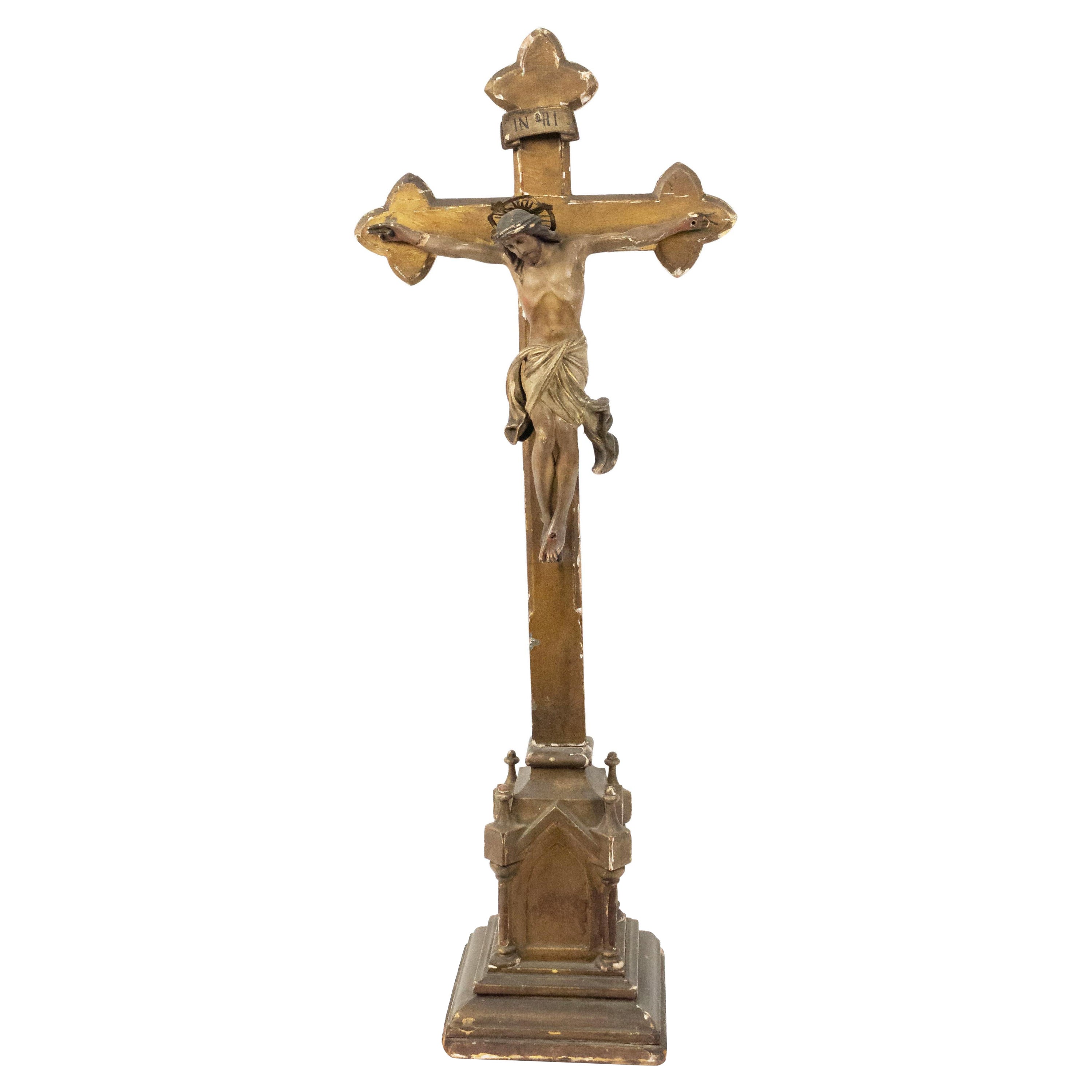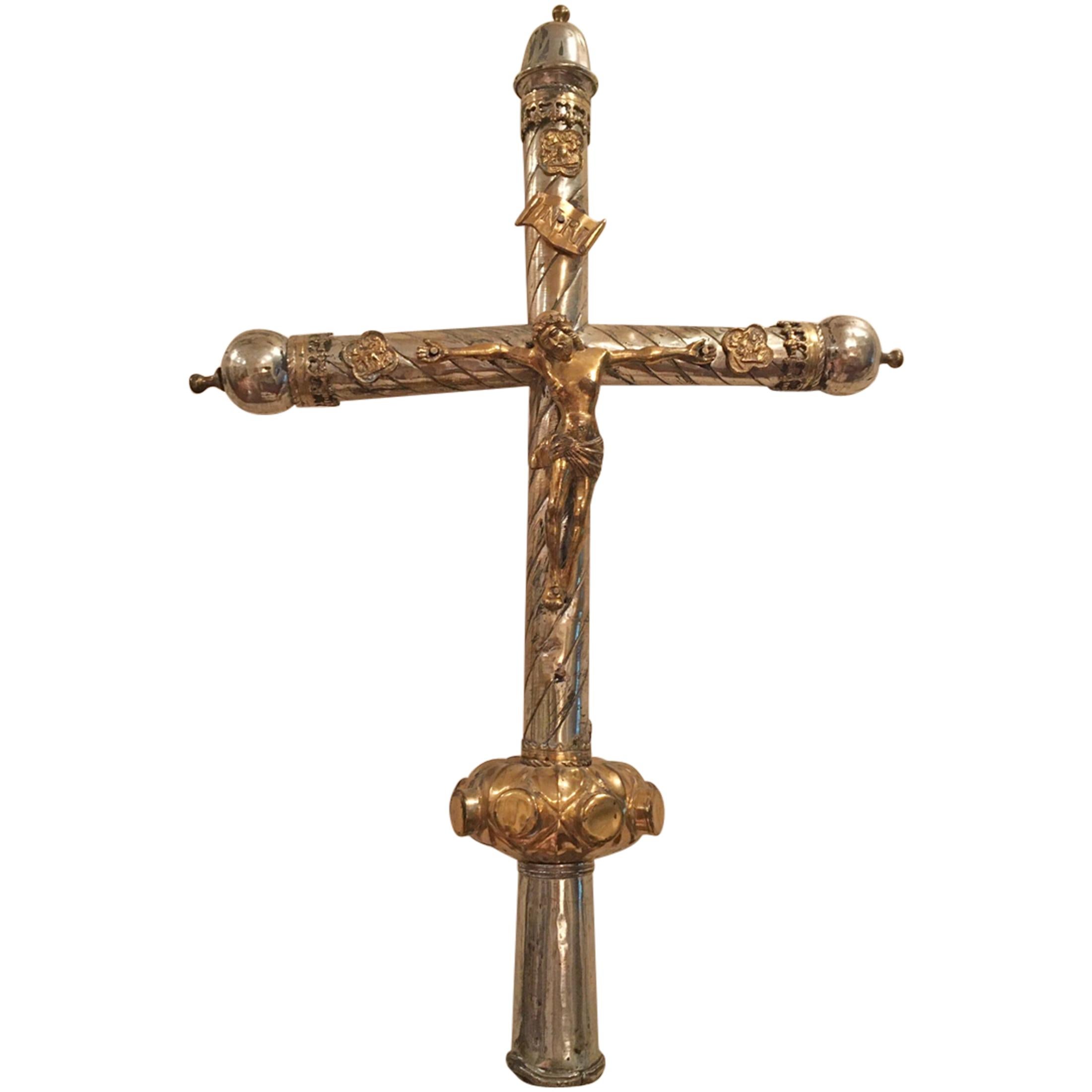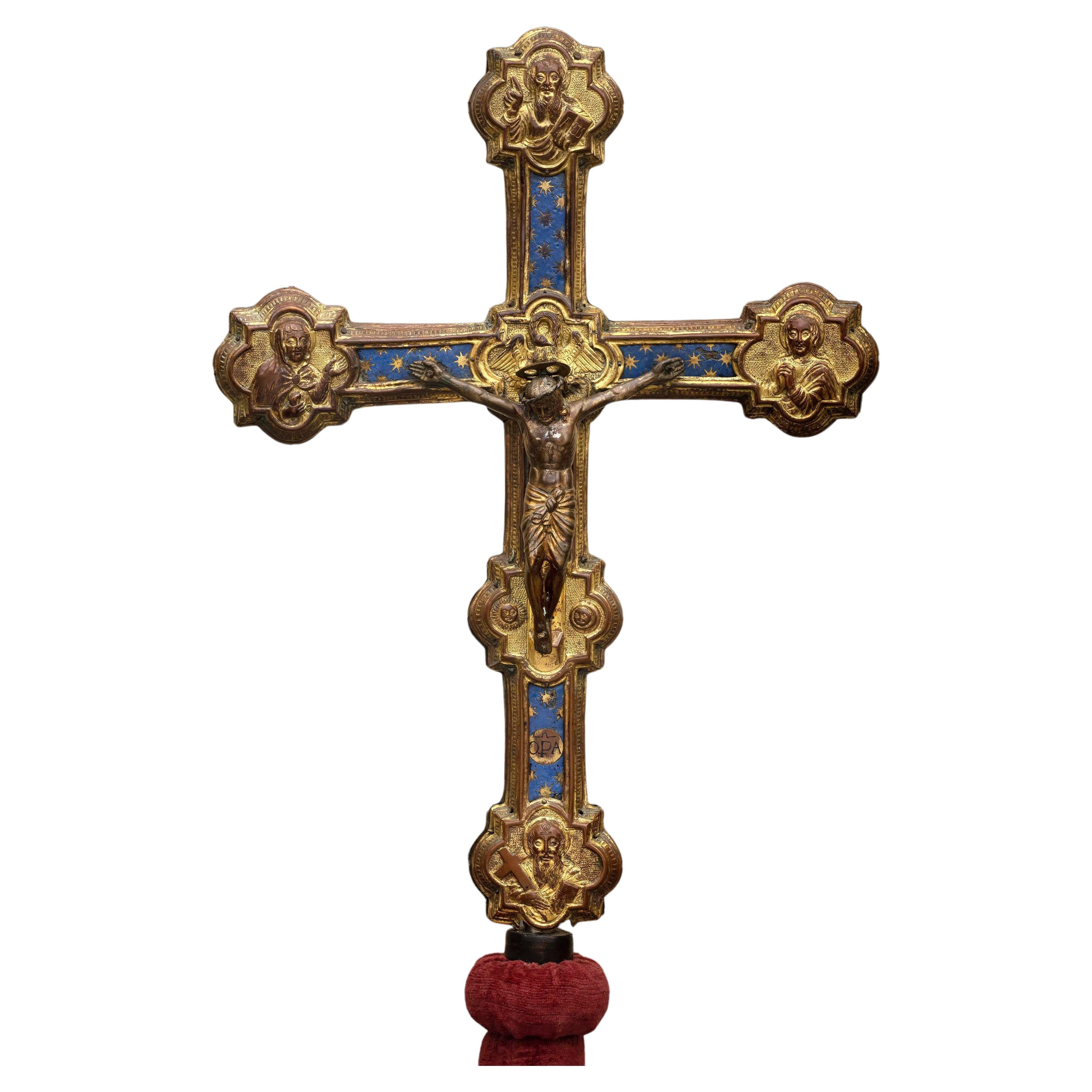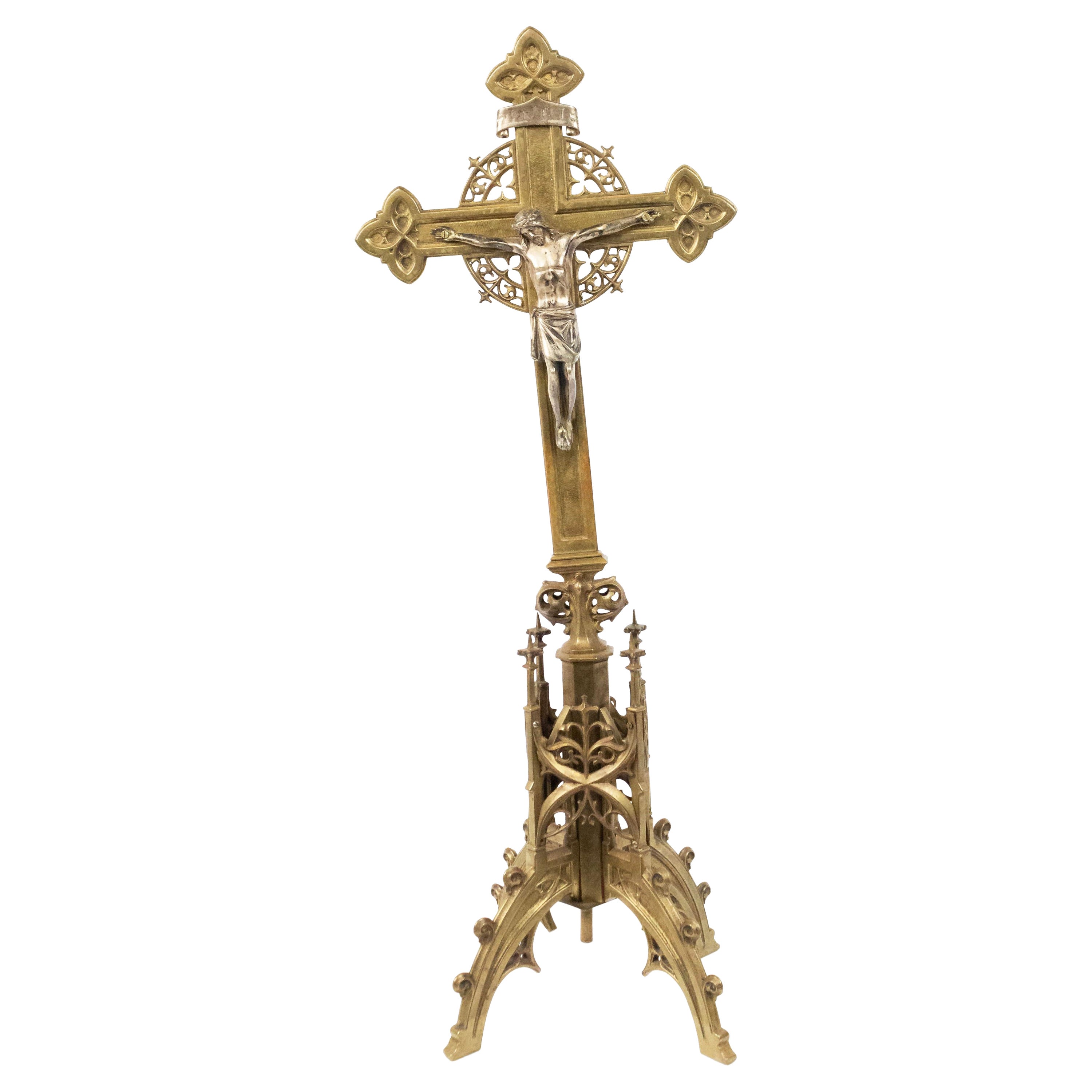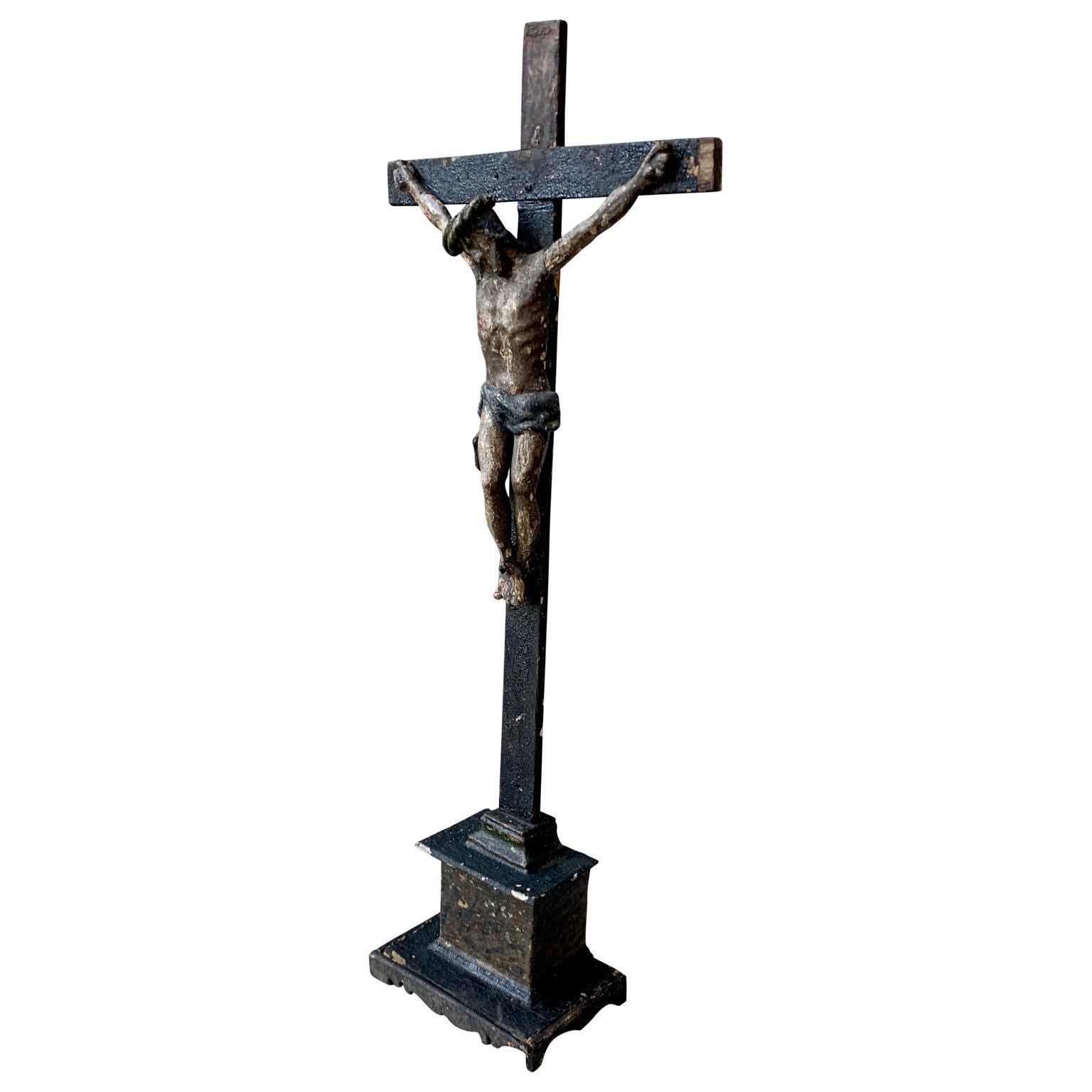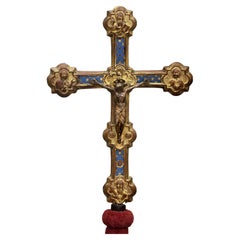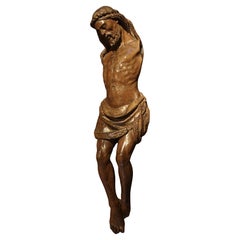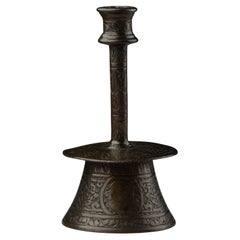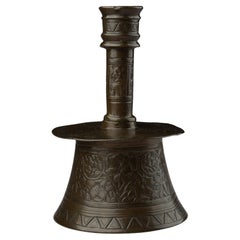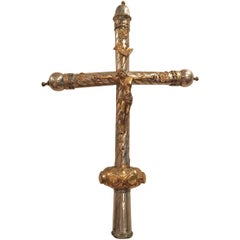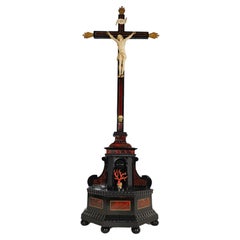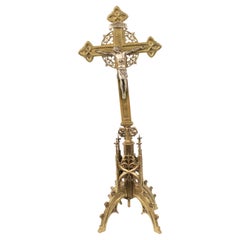Items Similar to renaissance wooden candelabrum and painted cross - Umbria, 16th century
Want more images or videos?
Request additional images or videos from the seller
1 of 8
renaissance wooden candelabrum and painted cross - Umbria, 16th century
$23,838.43
£17,651.57
€20,000
CA$32,781.42
A$36,456.11
CHF 19,083.09
MX$444,720.24
NOK 239,786.01
SEK 225,549.70
DKK 152,272.75
About the Item
Base of a carved wooden candelabrum, polychrome and gilded; cross painted on both sides.
Umbria or Tuscany, 16th century
136 x 43,5 x 30 cm
(The cross and the base of the candelabrum were later assembled)
The base of the candelabrum is intricately carved and adorned with polychrome and gilded finishes. The shafts take on the shape of balusters reminiscent of ancient columns, feature ornate foliage decorations, garlands and winged cherub faces. The feet are crafted in the likeness of lion paws. The base is further embellished with depictions of four saint martyrs, among them Saint Barbara and Saint Catherine of Alexandria. The plasticity of the figures, outlined with strong contour lines, the clear and vibrant colors, are stylistic elements linked to the Umbrian tradition of the sixteenth century.The precisely defined and elegant drawing, along with the clear color palette applied with refined chiaroscuro modulations, became the signature of a style that would leave a lasting mark on the era to come. This is exemplified by a preference for vibrant, multicolored images, accentuated in this case by the use of red and pink in the saint's attire.
A notable addition, introduced later, is a polylobed cross painted on both sides. On one side, the Crucifixion is vividly portrayed:The treatment of the corpus itself is in line with High Medieval practice, emphasizing pathos by showing Jesus dead, his arms sagging from the weight of the body. The upper section displaying a pelican pecks at her breast to feed her young with her own blood; a symbol of the sacrifice of Christ on the cross whose body and blood similarly nourishes the celebrant during Mass.
The lower part depicts Golgotha. On the reverse side, the Resurrection is artistically presented in a Renaissance iconography, reminiscent of the renowned composition painted by Piero della Francesca, now housed in the Civic Museum of Sansepolcro. In terms of composition, with the frontal depiction of Christ holding the banner, this motif became particularly widespread in central Italy, spanning from Tuscany to Umbria throughout the 16th century..
The double-sided construction suggests that it may also have been carried in liturgical processions. In Umbria from the 14th century, the use of portable crosses painted on both sides had become a widespread practice, aimed at satisfying the monastic clientele that had significantly increased following the establishment of new religious communities.
The earliest surviving Tuscan painted crucifix represent Christ as Christus Triumphans, or the “Triumphant Christ” with his head up and eyes open. This form was supplanted in the 13th century with the Christus Patiens, or “Suffering Christ” type who is shown often with his head fallen on his shoulder and his eyes closed, as In our cross. The iconography of the suffering Christ appears to have developed out of a new interest in Christ’s human nature, the development of the feast of Corpus Christi and with increased importance given to the Eucharist. The process of humanizing the figure of Christ reaches its peak with the abandonment of all the previous expressive conventions in favor of more realistic details we can observe in this Crucifix, such as the swollen belly, the arms stretched to the limit of muscle tearing, the body falling heavily forward, the abundant blood on
the wounds, and the cross firmly embedded in the rock of Calvary.
It's worth noting that Renaissance candelabra often underwent later modifications, as in this case the addition of the polylobed cross. This adjustment, while postdating the original creation, did not diminish the artistic value. Instead, they showcased the evolving tastes and preferences of subsequent generations, creating a dialogue between different periods ans tastes.
Large in proportion and richly carved, this candlestick base display great magnificence and artistic skills. The combination of purely decorative scroll-work and pictorial form is typical of 16th century Renaissance decoration.
As much as candelabra were used to sanctified Christian objects, they were also unmistakably associated with antiquity and pagan worship in the fifteenth and sixteenth century.
Candelabra both for illumination and burning incense, were widely used in antiquity and, like many Roman decorative objects, they came in extremely diverse forms. A walk down the Galleria dei Candelabri at the Vatican Museums gives a taste of this seemingly endless variety of marble candelabra composed of natural and artificial component parts.
In the fifteenth century, when candelabra became part of a larger lexicon of all ‘antica forms, they appear most commonly in sacred settings. Many of the earliest surviving examples, were produced by artists from Tuscany, and it is probably there that painters and sculptors first widely explored the potential of the classically inspired candelabrum.
This candelabra, adorned with antique classic forms, embody the spirit of the Renaissance, blending innovation with intricate designs inspired by ancient Roman aesthetics. The use of classic forms, including balusters, garlands, and acanthus leaves, reflected a conscious effort to evoke the grandeur of antiquity.
The Renaissance candelabrum adorned with antique classic forms is a testament to the period's fascination with the past and its commitment to artistic excellence. The seamless integration of classical aesthetics into functional objects like candelabra not only illuminated spaces but also illuminated the enduring appeal of ancient beauty.
Bibliographie :
H. BELTING, L’arte e il suo pubblico. Funzione e forme delle antiche immagini della passione, introduzione di G. Cusatelli, Bologna 1986
WALTER A. DYER, Furniture of the Italian Renaissance, Arts & Decoration (1910-1918), Vol. 7, No. 3 (JANUARY, 1917), pp. 131-134
Paul Davies and David Hemsoll,“Renaissance Balusters and the Antique,”Architectural History 26,1983
E. SANDERBERG VAVALÀ, La croce dipinta italiana, Verona 1929, II ed. Roma 1980,
Elvio Longhi, La passione degli umbri, Crocifissi di legno tra Medioevo e Rinascimento, 2021
- Dimensions:Height: 53.55 in (136 cm)Width: 17.13 in (43.5 cm)Depth: 11.82 in (30 cm)
- Style:Renaissance (Of the Period)
- Materials and Techniques:
- Place of Origin:
- Period:
- Date of Manufacture:16th century
- Condition:Wear consistent with age and use.
- Seller Location:Bruxelles, BE
- Reference Number:1stDibs: LU6666238299302
About the Seller
5.0
Vetted Professional Seller
Every seller passes strict standards for authenticity and reliability
1stDibs seller since 2022
15 sales on 1stDibs
Typical response time: 1 hour
- ShippingRetrieving quote...Shipping from: Bruxelles, Belgium
- Return Policy
Authenticity Guarantee
In the unlikely event there’s an issue with an item’s authenticity, contact us within 1 year for a full refund. DetailsMoney-Back Guarantee
If your item is not as described, is damaged in transit, or does not arrive, contact us within 7 days for a full refund. Details24-Hour Cancellation
You have a 24-hour grace period in which to reconsider your purchase, with no questions asked.Vetted Professional Sellers
Our world-class sellers must adhere to strict standards for service and quality, maintaining the integrity of our listings.Price-Match Guarantee
If you find that a seller listed the same item for a lower price elsewhere, we’ll match it.Trusted Global Delivery
Our best-in-class carrier network provides specialized shipping options worldwide, including custom delivery.More From This Seller
View AllPaolo di Giovanni Sogliani - Processional Cross Florence, around 1515
Located in Bruxelles, BE
Paolo di Giovanni Sogliani (Florence 1455-1522)
Processional Cross
Florence, around 1515
Enameled, chiseled, engraved, stippled, and gilded copper; wooden core ; Inscription: "OPA...
Category
Antique 16th Century Italian Renaissance Figurative Sculptures
Materials
Copper, Enamel
Christ - Umbria, second half of the 15th century
Located in Bruxelles, BE
Christ
Umbria, Orvieto?
Second half of the 15th century
77 x 16.5 cm
Category
Antique 15th Century and Earlier Italian Renaissance Figurative Sculptures
Materials
Walnut
Veneto- Saracenic candlestick - 15th century
Located in Bruxelles, BE
Veneto- Saracenic candlestick
Engraved bronze
15th century
12,5 x 6,2 cm
This rare candlestick exemplify exquisite craftsmanship, featuring a bell-shaped base with a flared foot ado...
Category
Antique 15th Century and Earlier Italian Renaissance Chandeliers and Pen...
Materials
Bronze
Veneto- Saracenic candlestick - 15th century
Located in Bruxelles, BE
Veneto- Saracenic candlestick
Engraved bronze
15th century
13 x 8,5 cm
This rare candlestick exemplify exquisite craftsmanship, featuring a bell-shaped base with a flared foot adorn...
Category
Antique 15th Century and Earlier Italian Renaissance Chandeliers and Pen...
Materials
Bronze
Statuette of the Virgin, South German circa 1600
Located in Bruxelles, BE
Statuette of the Virgin
South-German, circa 1600
sculpted wood
circa 1600
(right arm restored)
52 cm
Category
Antique 17th Century German Renaissance Religious Items
Materials
Wood
Cercle of Romano Alberti, Page, Around 1530-1540
Located in Bruxelles, BE
Cercle of Romano Alberti, dit Il Nero da Sansepolcro ( San Sepolcro, 1521-1568 )
Page
Mixed media : wood core, papier mâché, stucco, polychrome and gilded
Italy, around 1530-154...
Category
Antique 16th Century Italian Renaissance Figurative Sculptures
Materials
Stucco, Wood, Paper
$12,395 Sale Price
35% Off
You May Also Like
Italian Renaissance Carved Wood Crucifix
Located in Queens, NY
Italian Renaissance style (19th Cent) carved wood crucifix on square base with figure
Category
Antique 19th Century Italian Renaissance Religious Items
Materials
Wood
Period Renaissance Early 16th Century Processional Cross, France
Located in Vero Beach, FL
Exceptional Period Renaissance processional cross early 16th century, France
Extremely rare and beautiful processional cross from the early period of the French Renaissance. This ...
Category
Antique 16th Century French Renaissance Religious Items
Materials
Bronze
Large Cross with Christ from the 18th Century
Located in Madrid, ES
Large cross with christ from the 18th century. The cross is decorated with tortoise shell, ivory and ebony. The christ is sculpted in high quality ...
Category
Antique 18th Century Italian Baroque Figurative Sculptures
Materials
Wood
$2,336 Sale Price
20% Off
Italian Renaissance Bronze Crucifix
Located in Queens, NY
Italian Renaissance Gothic style (19th Cent) bronze religious crucifix with filigree cross on 4 legged base with silver plate Christ figure (19th Cent.)
Category
Antique 19th Century Italian Renaissance Religious Items
Materials
Bronze
18th Century Carved And Painted Wooden Crucifix From France
Located in Haddonfield, NJ
An early 18th Century antique hand carved and polychromed hand painted table crucifix from France with its original patina preserved.
This crucifix could possible date back as early ...
Category
Antique Early 18th Century French Baroque Sculptures and Carvings
Materials
Fruitwood
$920 Sale Price
20% Off
Antique/Vintage Gothic Altar Table Crucifix, Brass /Bronze Table Standing Cross
Located in Skien, NO
Richly Decorated Free-Standing Table Crucifix / Cross & Corpus of Christ from the first half of the 20th century.
Gothic style, crafted from brass/bronze, with a beautiful patina. I...
Category
20th Century European Gothic Revival Figurative Sculptures
Materials
Brass, Bronze
More Ways To Browse
Antique Wood Cross
Antique Wooden House
13th Century Furniture
16th Century Italian Furniture
Marble Cross
Italian Renaissance Architecture
Roman Cross
Cross Renaissance
Antique Wooden Crosses
Ornate Cross
Christ On The Cross
16th Century Italian Wood
Jesus Cross
Antique Italian Cross
Wood Corpus
Crosses With Christ
Wood Painted Decorative Columns
16th Century Cross
